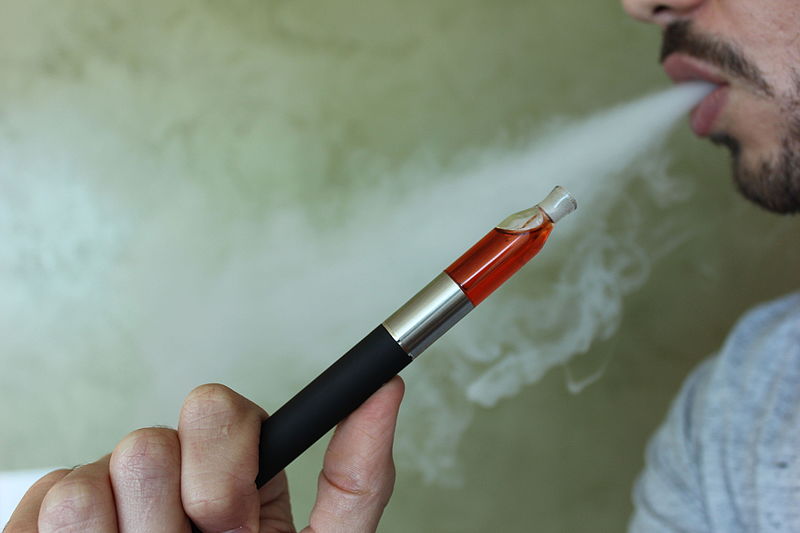
This Top 5 comes from NZ Initiative's Eric Crampton*.
As always, we welcome your additions in the comments below or via email to david.chaston@interest.co.nz.
We are always keen to find new Top 5 contributors so if you're interested in contributing, contact gareth.vaughan@interest.co.nz.
Today’s Top Five brings a mix of brickbats and bouquets.
On the brickbat side, we have a few stories showing why folks are increasingly sceptical of the news. Journalism has to do better than this. Once trust in the media is lost, we can wind up in bad places.
But we will have a few bouquets as palate cleanser after that introduction.
1, The perils of dogy vaping vendors

Cannabis is legal in many places in the United States. And vaping THC has picked up as a healthier alternative to smoking. But there’s a problem: dodgy, illicit vendors. THC vapers mainly assess the THC oil content in a vape cartridge by its viscosity: the way it sloshes when shaken. Adding other oils is one way of keeping up the viscosity while reducing the amount of expensive cannabis oils. But heating and inhaling dodgy oils can be toxic, even fatal. The oil coats the inside of the lungs because vape sticks cannot heat it enough to aerosolise it.
Officials are still trying to explain the sudden increase in people winding up in hospital after vaping. Dodgy oils in cartridges sold by black market THC vape carts are the most plausible culprit. The Washington Post reported the story on 6 September, noting that a Vitamin E oil was found in almost all cannabis samples from folks in New York State who wound up sick.
The lesson for Kiwis who vape as a healthier alternative to smoking is to buy their vaping liquids from trusted and trustworthy sources. It is still possible for dodgy oils to be imported before regulations kick in. This scenario seems far less likely to happen with nicotine vaping – making the e-juice thicker by adding oils won’t make for a more attractive-looking product. But it’s good to know that your e-liquids are coming from a place that cares about quality control.
That wasn’t the story Radio New Zealand ran. Instead, its headline, tweet, and story summary read “Second US death linked to vaping” – that the death was linked to a cannabis product rather than nicotine was mentioned only later in the story.
And Thursday morning’s 7am RNZ news bulletin noted Trump’s crackdown on flavoured e-cigarettes and the “spate of vaping-related deaths” without a single word about that American officials, according to the Washington Post, “are narrowing the possible culprits to adulterants in vaping products purported to have THC".
Blanket scaremongering about vaping does not help people make informed choices. Vapers could use a heads-up about the importance of buying products from trusted suppliers rather than potentially risky products from no-name dodgy suppliers. Moral panic around nicotine vaping risks discouraging people from flipping over from smoking tobacco – which is far riskier than vaping.
For better reporting on vaping more generally, read Jenesa Jeram at The Spinoff.
2. More fake news...
Last week, piles of stories blew around news outlets about the amount of litter piling up in New Zealand. The Herald’s Science reporter picked it up, along with just about everyone else. Keep New Zealand Beautiful ran a national litter audit. Their underlying work looks important and sound. They surveyed piles of litter at sites where people tend to litter. That’s important work. Unfortunately, they also wanted big headlines driven by big numbers. So how do you generate a mega number on litter? You take the litter you find in car parks, in retail spots, along the highways, and in other places where people tend to litter; get an average amount of litter per 1,000 square metres from those places; and multiply it by the number of 1,000 square metre places in New Zealand. As Auckland University statistician Thomas Lumley put it, “think of a number, and multiply it by 260,000,000”.
The obvious problem with this method is most of New Zealand, by area, is nothing like the places the litter audit sampled. Around 78% of the country is effectively uninhabited, with a population density of less than one person per square kilometre. Counting the litter in places likely to have litter, then assuming the same amount of litter for all of New Zealand, including the most remote and inaccessible parts of Fjordland – well, it’s either mad or deliberately dishonest.
Then there were the stories about 10,269,090,000 cigarette butts littered all over the country. It only takes basic numeracy to see how monumentally wrong the number was. The Herald reported that “some 10,269,090,000 were picked up”. Except it would take an army of 325 people working non-stop, without sleep, all year, picking up one cigarette butt per second to collect that many butts.
Or, think about it another way. The government collects just under $2 billion per year in tobacco tax, and the tax on each cigarette is just under a dollar. That’s about two billion cigarettes smoked in New Zealand per year. Does it seem plausible that every cigarette smoked in New Zealand for five years was littered and every one of those butts was still around to be counted?
You can run similar calculations in your own head about the utter implausibility of 394,965,000 litres of disposable nappies littered in New Zealand. Think about it. About 60,000 kids are born in New Zealand every year. How many nappies does each one go through? Is it possible that almost 395 million litres of nappy litter was generated, even if every nappy used by every kid in the country, for the first years of their lives, were littered? It really does not seem likely.

Littering is a real problem. It sucks. But using misleading methods to generate big and implausible numbers risks discrediting the rest of the work in the report – which is sound!
It is just so depressing that nobody reporting on these stats ran a basic plausibility check on them. The numbers do not survive a half-minute’s careful thinking. Journalists aren’t stupid, but they are time constrained. When a big number shows up, and is accompanied by a report claiming that Statistics New Zealand, the Department of Conservation, and the Ministry for the Environment helped design the National Litter Audit, I think the journalists just don’t bother spending that half-minute to think whether the number makes any darned sense. Imprimatur from officialdom, combined with the number’s congruence with the zeitgeist of environmental doom, means journalists’ scepticism disappears.
But for folks with half a brain willing to spend more than half a minute with the numbers, trust in journalism disappears instead.
And if you want to be even more depressed, think for a minute about the market for news. If an automobile model were as unreliable as news reporting, demand for that brand would disappear. That forces automobile makers to produce generally reliable cars.
What does this kind of sloppy, credulous media reporting say about our demand for accurate news?
3. The misleading cost of alcohol...
This will be the last fake news fake stat in this sad litany. Y’all would have seen the $7 billion figure floating around, purporting to update the social cost of alcohol. It saw a lot of reporting last month during the Alcohol Action New Zealand annual conference, where the media reported it as a $70 billion cost rolled over 10 years. I did a bit of nosing around. The number was first released last year by BERL as an update to their 2009 figure, which was based on data from 2005/6. That number was subject to strong critique at the time because it added the amount drinkers spent on their own alcohol, double-counted other costs, assumed that heavier drinkers get zero benefit from their consumption, and presented a pile of individual costs predominantly experienced by drinkers themselves as a social cost to the country as a whole.
So what’s the updated figure? BERL took the old figure. It looked at GDP growth since the 2005/6 figure, assumed that alcohol harm was the same fraction of GDP, and multiplied the old number by GDP growth. That’s it. And everyone who forgot that the old number was rubbish reported on the updated figure as the new cost of national alcohol consumption.
But enough of depressing reporting. Here are a couple good ones.
4. Sorting the trees from the trees on climate change

I enjoyed Eloise Gibson’s explainer on trees and New Zealand’s climate change goals, the reasons folks choose pinus radiata, and the trade-offs involved. Gibson’s reporting has been great. Too often, when you read stories on topics you know something about, you despair about the journalists covering them. Gibson’s reporting is the opposite. When she reports on topics I already know about (I’ve done a fair bit of work on freshwater management), I learn new things rather than find myself angry about what they got wrong. I love that.
5. The joyful contrarian
Finally, my favourite read of the past month: Michael Munger’s article on Gordon Tullock. Gordon is the best economist you’ve never heard of. And he has a wonderful story. He was a US State Department official after a stint in the Army (and a landing at Normandy shortly after D-Day), and was overrun by the communists in China – and later in Korea. He came to economics proper only later in life. But he’s the best exemplar ever of the natural economist – the type who applies economic intuition systematically across everything. And he was one of my teachers in graduate school. Munger calls him a “joyful contrarian’. He’s right.
“In 2019, we will pass the 70th anniversary of the Communist takeover of China, an event that Tullock witnessed in person from the vantage point of his diplomatic post in Tientsin. That experience launched his thinking about the problem of governance, anarchy, and the importance of rules. Looking back, many of the insights that powered his work from that time—once dismissed not just as counterintuitive but as outlandish—have now become conventional wisdom.
There are lots of contributions worth examining, including his work on voting, bureaucracy, and constitutional theory. But those fit reasonably well into the "public choice" tradition, which Tullock helped found, and are easily accessible to those interested in that approach. I will consider three of Tullock's less well-known, but probably even more important, insights—regarding safety regulation, corruption, and the rationality of evolved behaviors—and see how this work has stood the test of time. The three are very different, but they are unified by one feature that is the hallmark of the economic approach: In every case, Tullock reached a conclusion but pressed further to ask, "And then what?"”
The piece is well worth your time.
UPDATE: KNZB updated its site to remove the dodgy statistics shortly before this Top 5 went to press; I hope that the news outlets that reported on it will issue the appropriate corrections.
*Dr Eric Crampton is Chief Economist with the New Zealand Initiative. He hopes that the Herald might eventually fix the story about littering, but is not optimistic.
8 Comments
#5 An interesting article, and I agree - worth reading. On safety I totally agree. In this country alone, the bureaucrats seem to be trying to regulate to protect people from their own stupidity, rather than holding them accountable for failing to think. Even the ACC system is a piece of this puzzle, and that is failing us more and more.
“Littering is a real problem. It sucks. But using misleading methods to generate big and implausible numbers risks discrediting the rest of the work in the report – which is sound!”
Yup, kind of like what has happened in the past with Climate change (and to this day with the Amazon fires for that matter). Drastically exaggerating is one way to be very counterproductive.
I'm afraid I've been a cynic & a skeptic for some time now. I wasn't always, but when you hear what you hear day after day on our sub-standard mainstream media channels, you quickly learn that a) they are not new stories, they are updates of similar stories we've been told forever b) that the story they tell you is their version of their story they want you to hear and c) by the time get round to seeing or hearing any daily news I've read it three times already from outside global sources (which as you are rightly thinking) are probably just as biased as our ones are.

We welcome your comments below. If you are not already registered, please register to comment.
Remember we welcome robust, respectful and insightful debate. We don't welcome abusive or defamatory comments and will de-register those repeatedly making such comments. Our current comment policy is here.